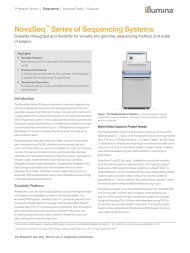Abstracts
ngsfinalprogram
ngsfinalprogram
You also want an ePaper? Increase the reach of your titles
YUMPU automatically turns print PDFs into web optimized ePapers that Google loves.
Poster <strong>Abstracts</strong><br />
n 66<br />
DELINEATING COMMUNITY OUTBREAKS<br />
OF SALMONELLA ENTERICA SEROVAR<br />
TYPHIMURIUM USING WHOLE GENOME<br />
SEQUENCING: INSIGHTS INTO GENOMIC<br />
VARIABILITY WITHIN AN OUTBREAK<br />
S. Octavia 1 , Q. Wang 2 , M. Tanaka 1 , S. Kaur 1 , V.<br />
Sintchenko 2 , R. Lan 1 ;<br />
1<br />
University of New South Wales, Sydney,<br />
AUSTRALIA, 2 Westmead Hospital, Sydney,<br />
AUSTRALIA.<br />
Whole genome next generation sequencing<br />
(NGS) was used to retrospectively examine 57<br />
isolates from five epidemiologically confirmed<br />
community outbreaks (designated as Outbreak<br />
1 to Outbreak 5) caused by Salmonella enterica<br />
serovar Typhimurium (S. Typhimurium) phage<br />
type DT170. Most of the human and environmental<br />
isolates confirmed epidemiologically<br />
to be involved in the outbreaks were either<br />
genomically identical or differed by one to two<br />
single nucleotide polymorphisms (SNPs) with<br />
the exception of Outbreak 1. The isolates from<br />
Outbreak 1 differed by up to 12 SNPs, which<br />
suggests that the food source of the outbreak<br />
was contaminated with more than one strain<br />
while the other four outbreaks were caused by<br />
a single strain. In addition, NGS analysis ruled<br />
in isolates that were initially not considered to<br />
be linked with the outbreak, which increased<br />
the total outbreak size by 107%. The mutation<br />
process was modelled using known mutation<br />
rates to derive a cut-off value for the number<br />
of SNP difference to rule-in or rule-out a case<br />
being part of an outbreak. For an outbreak with<br />
less than one month ex vivo/in vivo evolution<br />
time, the maximum number of SNP differences<br />
between isolates is two and four SNPs<br />
using the slowest and the fastest mutation rates<br />
respectively. NGS of S. Typhimurium significantly<br />
increases the resolution of investigations<br />
of community outbreaks. It can also inform<br />
more targeted public health response by providing<br />
important supplementary evidence to<br />
rule-in and rule-out cases of disease associated<br />
with foodborne outbreaks of S. Typhimurium.<br />
n 67<br />
DEFINING CORE GENOME OF SALMONELLA<br />
ENTERICA SEROVAR TYPHIMURIUM<br />
FOR GENOMIC SURVEILLANCE AND<br />
EPIDEMIOLOGICAL TYPING<br />
S. Fu 1 , S. Octavia 1 , M. Tanaka 1 , V. Sintchenko 2 ,<br />
R. Lan 1 ;<br />
1<br />
University of New South Wales, Sydney,<br />
AUSTRALIA, 2 Westmead Hospital, Sydney,<br />
AUSTRALIA.<br />
Salmonella enterica serovar Typhimurium is<br />
the most common Salmonella serovar causing<br />
food borne infections in Australia and many<br />
other countries. Twenty one S. Typhimurium<br />
strains from Salmonella reference collection A<br />
(SARA) were analyzed using Illumina highthroughput<br />
genome sequencing. SNPs in 21<br />
SARA strains range from 46 SNPs to 11,916<br />
SNPs with an average of 1,577 SNPs per<br />
strain. Together with 47 selected from publicly<br />
available S. Typhimurium genomes, the S.<br />
Typhimurium core genes (STCG) was determined.<br />
The STCG consists of 3,846 genes,<br />
which is much larger than the set of 2,882<br />
Salmonella core genes (SCG) found previously.<br />
The STCG together with 1,576 core<br />
intergenic regions (IGRs) was defined as the S.<br />
Typhimurium core genome. Using 93 S. Typhimurium<br />
genomes from 13 epidemiologically<br />
confirmed community outbreaks, we demonstrated<br />
that typing based on S. Typhimurium<br />
core genome (STCG+ core IGRs) provides<br />
superior resolution and higher discriminatory<br />
power than that based on SCG for outbreak<br />
investigation and molecular epidemiology<br />
of S. Typhimurium. Both STCG and STCG+<br />
core IGRs typing achieved 100% separation<br />
of all outbreaks in comprison to SCG typing<br />
which failed to separate isolates from two<br />
outbreaks from background isolates. Defining<br />
the S. Typhimurium core genome allows<br />
standardization of genes/regions to be used for<br />
high resolution epidemiological typing of S.<br />
Typhimurium for genomic surveillance.<br />
84<br />
ASM Conferences



